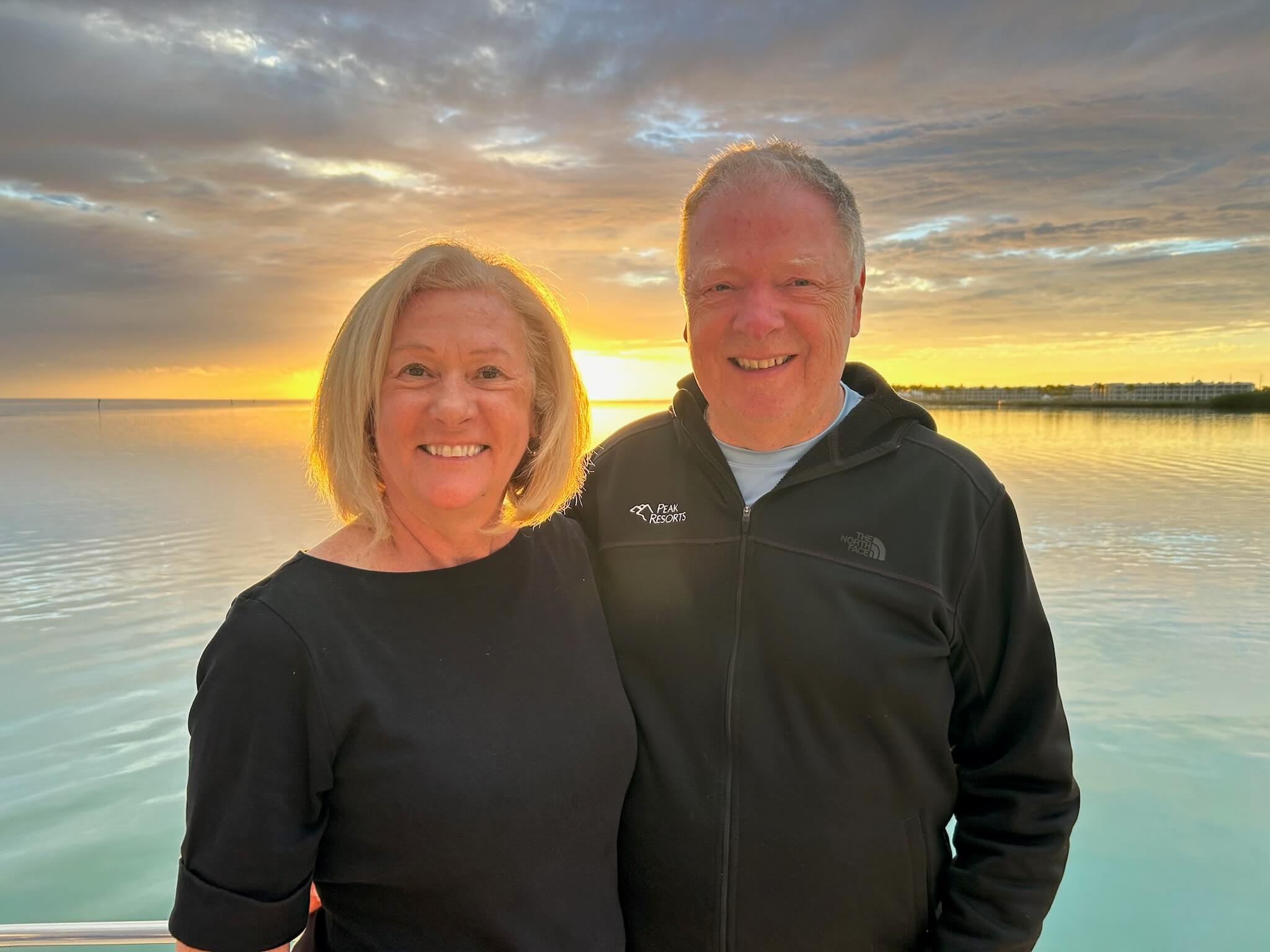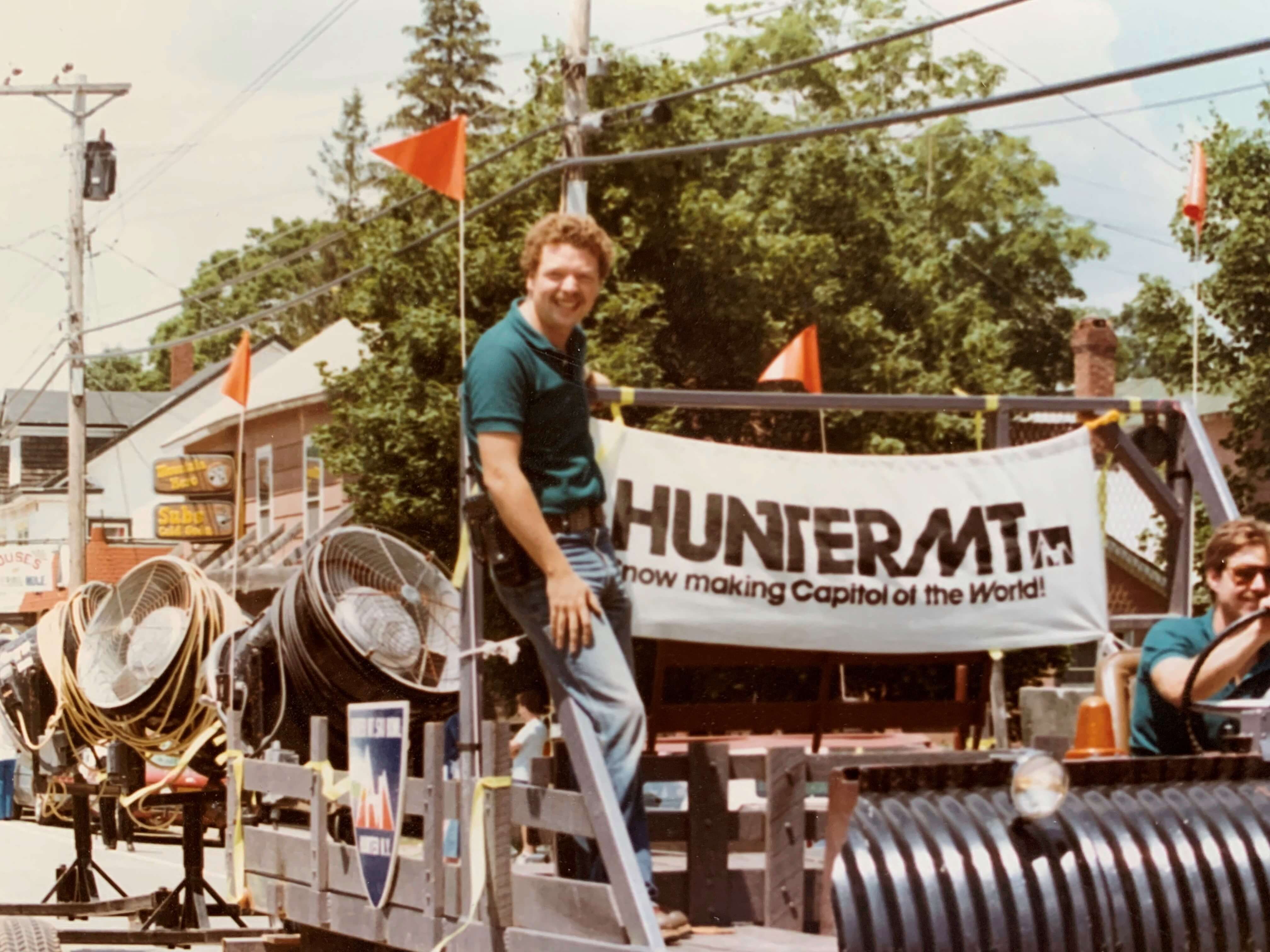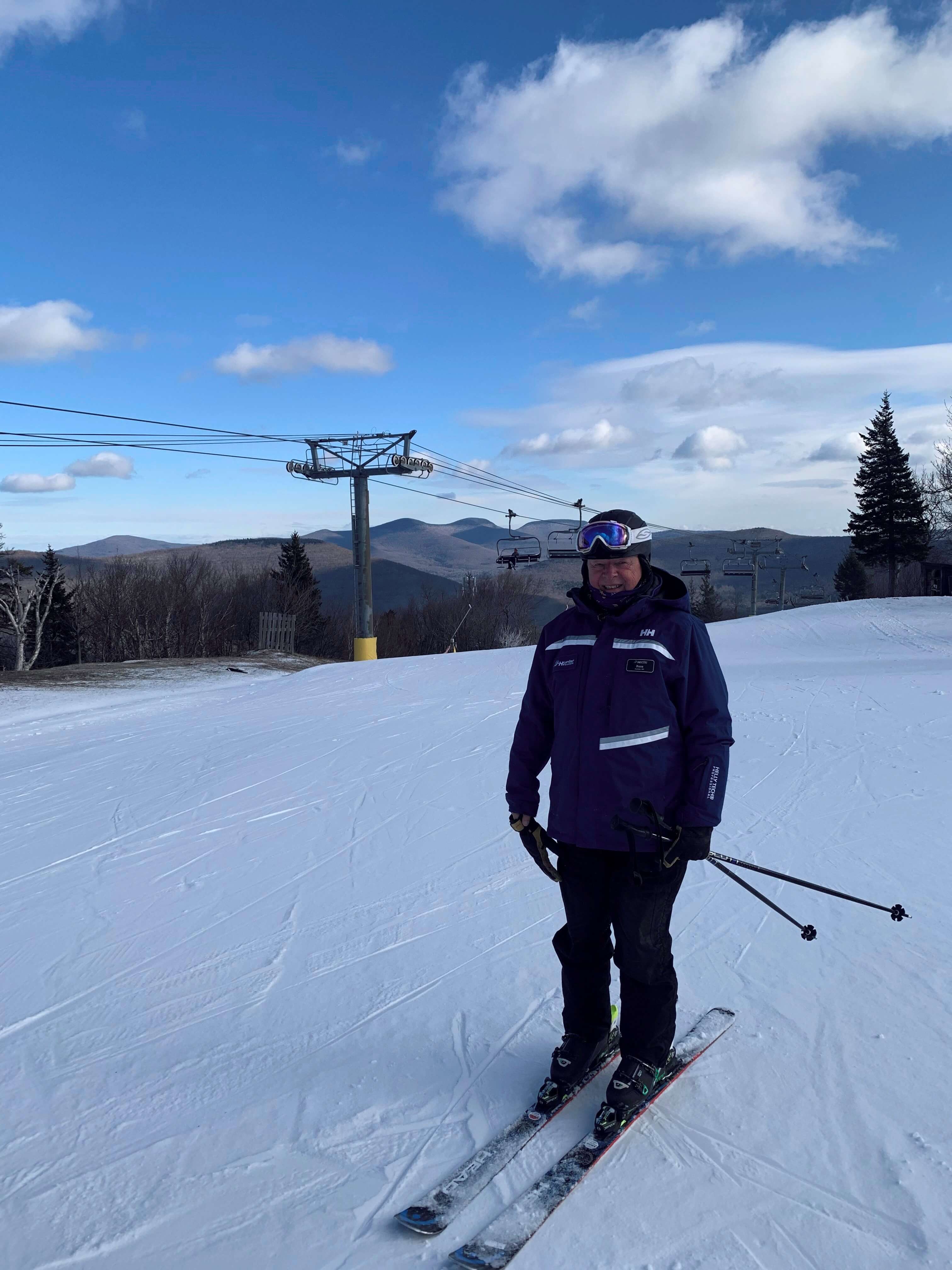2024 NSAA Lifetime Achievement Award: Russ Coloton, Master of Change
By Heather B. Fried

In a way, Russ Coloton, who recently stepped down as GM of Hunter Mountain, N.Y., after a 44-year career there, engineered his own ski industry ascension. He worked as a lift operator in high school, eagerly taking on whatever other jobs he could get his hands on.
Coloton was an early graduate of Gogebic Community College’s Ski Area Management program, at which point he went right back to jumping at every opportunity to accumulate skills and experience, making himself useful while learning the ins and outs of operations. This willingness to dress for the job you want, so to speak, proved valuable when it came time to move into a rare leadership opening at Hunter and serve through three administrations there — first for the family-run ski area, last for the largest operator on the planet, and a mix of the two in between.
"Russ spent his entire ski area career at Hunter Mountain — most of that working for two brothers that trusted in his ability to lead the team through many years of ups and downs that come with eastern weather and N.Y. regulations," said Sarah Slutzky, director of skier services at Hunter Mountain and granddaughter of Orville Slutzky, one of the founding brothers. "Running a successful ski area in the East takes a special type of resiliency, and then we bring family dynamics into it. That was not for the faint of hearts!
"He then was able to hold the reins steady through two corporate acquisitions, all while maintaining the trust and dedication of the Hunter team," Slutzky continued. "Not everyone in this industry could lead through such change and adversity, but Russ did so in a way that truly set Hunter up for success, no matter what we faced. Those of us that worked for Russ are all better for it."
If the ability to navigate change with grace and agility is the mark of an adept leader, then everyone in the industry can agree that Coloton is one of the greats. Seeing the ski area through so much transformation took humility, open-mindedness, curiosity and detachment from ego — traits he modeled fearlessly as he helmed Hunter through uncertain waters.
Ski Fever
Coloton grew up in Utica, N.Y., with city-run Val Bialas Ski Area in the middle of town. He skied there with friends growing up, but it wasn’t until his senior year in high school that he caught the bug. After teaching tennis lessons for a while, Coloton got an offer from the Parks Department to join Val Bialas as a part-time lift operator, and ski fever ensued.
"I’d been attracted to all of the parts that you have to pull together to get to make a ski area work, and at that time, I was lucky that they kind of used me a little bit everywhere," said Coloton. "From being a lift operator … I started early on learning to drive a snowcat and making snow."
Following high school, he stayed on with the ski area while attending a local community college and pondering his future direction. The path forward came into focus when he was introduced to the Ski Area Management program at Gogebic Community College. It was off to Michigan’s Upper Peninsula to live, eat and breathe ski area operations during the two-year program. 
For his second-year internship, Coloton had his pick of several Colorado resorts or Sugarbush, Vt. He opted to return to the Northeast, both because he had family and connections nearby, and the offering was more appealing — where the Colorado ski areas wanted their interns to choose a specific department, Sugarbush allowed them to explore roles across operations, from snowmaking and lift maintenance to grooming and ski patrol.
Coloton stayed on with Sugarbush that summer to run trail crew on a stormwater mitigation effort, part of a large snowmaking infrastructure project. While satisfied professionally, the young and single Coloton found the social scene a bit sleepy there. So he reached out to Orville Slutzky, owner of Hunter Mountain, N.Y., a newer networking contact in his rolodex.
"We had gotten free invites as [Gogebic] graduates to go to the NSAA Convention, which was held that year at the Lake Geneva Playboy Club in Wisconsin," Coloton said. "I actually met Orville at that point, and we started a little bit of a dialogue."
The two eventually got back in touch. Hunter was more his speed, with a lot of summer activities going on, and Coloton started as a lift supervisor for the Catskills ski area, also going out grooming, snowmaking and helping in other ops capacities after his shift. Early mountain operations exposure catapulted Coloton into more roles as he worked his way up to operations manager. With Slutzky by his side, Coloton continued to take on greater responsibilities, from finance to risk management, allowing the aging owner to continue on as GM while Coloton handled many of the daily duties.
"At the time being privately owned, we didn't have a ton of opportunities," explained Coloton, who called it a steel ceiling if felt so impenetrable at times. "Frankly, we had a lot of people that worked there a long time because it was such a great place to work, and it was a family-owned business."
Coloton could have been considered family adjacent. He classified his relationship with Slutzky as more than a mentor, having grown close after spending so much time learning from a leader he thought of as a forefather in this industry with an incredible work ethic. He also appreciated that Slutzky, a fellow NSAA Lifetime Achievement Award honoree, wasn’t afraid to question the ideas that didn’t appeal to his solid common sense.
Stepping into the GM role at Hunter in 1999, Coloton took pride in both having helped Slutzky remain at the helm for as long as he wanted to, and in “the ability to help the Slutzky family when the time was right to exit the business.”
That time came in 2016, when Peak Resorts acquired Hunter Mountain for $36.8 million.
C-lift to C-suite
"Russ rose through the ranks to become Hunter’s president and helped the Slutzky family shepherd its sale to a publicly traded company, Peak Resorts, and, a few years later, the sale of Peak to one of the real ski industry behemoths, Vail Resorts," said Carol Schrager, a close colleague and friend who joined Hunter Mountain as legal counsel around the time Coloton started. "So, Russ literally went from C-Lift to the C-suite."

"Russ not only straddled the chasm between the mom-and-pop ski areas of yesteryear and the mega conglomerates of today, he helped build the bridge," Schrager went on.
Michael Berry, NSAA’s former president, agreed with Schrager, noting that Coloton succeeded in all three environments. Though the operating philosophies among the owners differed, on a day-to-day basis, the task at hand was the same; Coloton’s expertise carried weight and carried through.
"Russ [had an] insider understanding of how Hunter worked, what its capabilities were in terms of snowmaking and what the impacts of being two hours from New York City were," explained Berry. "Russ carried a book of knowledge that served him well under all three owners."
What also served Coloton well was his attitude as a lifelong learner, coupled with Slutzky’s mantra: "You’re either moving forward or you fall behind." Another asset was their habit, as a privately-owned ski area, of studying outside resources for clues on how to improve their own operation. As part of that, Coloton always kept a close eye on Vail Resorts, and policies like employee helmet mandates, long before they acquired Hunter.
"Being a student of the industry, I was curious to see … how would Vail operate a resort our size?" said Coloton. "When they started purchasing resorts in the Midwest, I spent time looking at where they changed things, how they changed products and stuff like that, just to see if we could learn something from that, or if there was something that would work for us. So … I already had that curiosity."
Possessing that mindset came in handy for Coloton, who saw acquisition as an opportunity to better Hunter. Even so, there were inevitable challenges, and Coloton actually found the transition to Peak Resorts more difficult for the team "because a lot of our folks didn’t see it coming."
"Selling to a publicly traded company, there's a lot of confidentiality, and so it was a pretty tight circle of people that knew what was going on," he added. "I think for folks that was a bit of a shock; it took some time."
After working their way through that, the 2019 transition from Peak to Vail Resorts was much more seamless, according to Coloton. Upon hearing the announcement of the sale to Vail, he called up Bruce Schimdt, VP and GM at Okemo Mountain Resort, Vt., to learn about his acquisition and transition experience from the year before. Schmidt’s advice? There’s no dipping a toe to test the waters. You have to be all in, 100% committed.
"Change is difficult for people, and you've got to be willing to accept change or it isn't going to work," said Coloton. "Companies have different ways of operating, and some of it you're going to learn from, and it's going to be good, and there's other things that companies are going to learn from you. You try to share what you've done well, and sometimes that works out immediately, and sometimes it takes a little while, but you’ve got to be willing to."
What can be hard at the GM level, he added, is that your team, programs, the way the resort is built and how it functions are all part of the mark you’ve made at a ski area. Much of that changes with an ownership handover. In these specific cases, it was the increasing centralization of many roles that "was different and a little difficult," Coloton explained. Still, his takeaways from leading through two high-profile and relatively rapid-succession acquisitions are overwhelmingly positive.
"I had seen other acquisitions where companies come in and maybe are a little arrogant, and I never saw that," he said. "Both with Peak and with Vail Resorts, people came in and saw Hunter as a successful operation, wanted to learn from us, but also with the understanding that not everything's going to be the way it used to be. But it was handled with respect and with curiosity, as opposed to just coming in and saying, ‘This is how we do it.’"
"For me, that worked out well," added Coloton.
What’s worked out well for his team is that they became part of a network of ski areas. This lent a competitive advantage in terms of access to Vail Resorts’ best practice group structure of information sharing, as well as the ability to more easily grow their career. Instead of butting up against a steel ceiling and having to move on, "we've been able to export that talent to other opportunities within the company," said Coloton, which is something he laments not exploring himself, if only slightly.
"I joke around about this — it would have been nice to work at a resort where we got a little more natural snow from time to time," he laughed. "I would have liked to maybe geographically done some movement early in my career, but I have no complaints. I've worked with great people, I've worked with three wonderful companies, and now I'm good."
Co(o)loton Under Pressure
Although he never experienced it firsthand, Coloton remained in the know about what was happening in the industry nationally through serving two six-year stints on NSAA’s board of directors, from 1991–1997 and again 2010–2016. He found it extremely valuable to work with this group behind the scenes and understand the trends to watch.
"Being able to take that information back and say … ‘This could be coming our way, and so this is something that we, as in New York State or the East … maybe should be paying attention to," he explained, giving the example of vendor markets, a common topic of conversation among the board then and now. "We used to order ski lifts in December or January for that year, and now, you're a year ahead of time."
During his terms on the board, Coloton represented his region well, according to Berry, who remembered him as "one of those guys that we kept turning to for that mid-Atlantic seat." Not only was he well connected across the state, having also served on the Ski Areas of New York (SANY) board, but he was willing and able to make that commitment to NSAA, and was "a good voice for the mid-size ski area," added Berry.
Likewise, Dennis Eshbaugh, president and GM of Holiday Valley Resort, N.Y., thinks of Coloton as a student of the facts and someone peers would listen to for balanced and logical guidance. Eshbaugh worked with Coloton through SANY, NSAA and other associations, becoming friends, sharing information and collaborating over 40+ years. He also appreciated Coloton’s ability to be an accomplished and superior operator without "an ounce of hubris in his demeanor."
"Russ was a friend to all … and would even be respectful when challenged by someone who didn’t understand the art of collegial discourse," said Eshbaugh. "He was tireless in his commitment not only to Hunter Mountain, but industry associations, including NSAA, SANY, ASTM, NYS Tramway Council and a long list of committees. Russ was also a leader and legislative chair who helped all 50 ski areas navigate the regulatory environment of New York State."
On a Boat
Coloton set sail, literally, into retirement last year aboard the Après Ski (he was on his boat in the Florida Keys, complete with great WiFi connectivity and a fishing vessel blasting music in the background, for this interview). Coloton and his wife, Pam, embarked southward on the Intracoastal Waterway after he helped get the resort open for the season.
Come spring, the two will pull up anchor and work their way back to their home near Hunter Mountain, where they’ll "still keep a dirt house." Beyond that, he has loose plans to sail, ski and make the most of his QTR, or quality time remaining — an idea passed down from Blaise Carrig via Michael Berry about seizing the ability to travel and seek adventure in retirement.
A couple months in, Coloton hadn’t quite disconnected from the ski area. He has regular chats with his successor, Trent Poole, and reflexively checks the webcams and forecast. But he doesn’t really plan to fully disengage, either.
"I think it was good to get out of town for me because I’d have the binoculars out wondering why snow wasn't being made there, so this was a good break for me," Coloton laughed. "But at some point, I would like to have some connection with the industry."
He’s still figuring out how that will materialize, just like he’s figuring out life after breaking with the routine of waking up with the sun and working long days. That adjustment is just the next lesson for a lifelong learner like Coloton, and one that he’s more equipped than most to master.